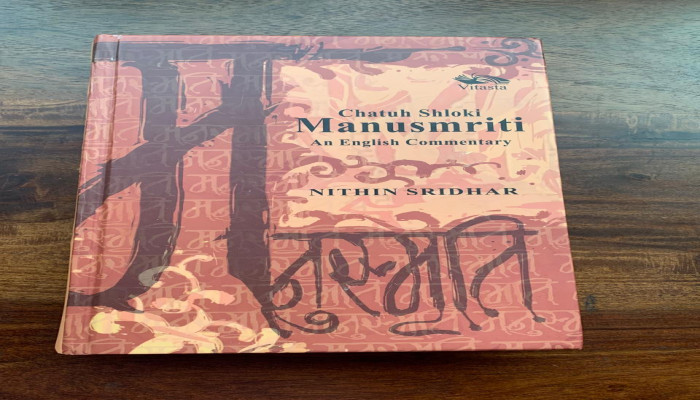Nithin Sridhar's Chatuh Shloki Manusmriti: An English Commentary
- In Book Reviews
- 01:17 PM, Sep 21, 2025
- Ramaharitha Pusarla
British Indologist William Jones selected the Manusmriti as the authoritative text for framing the Hindu Law Code, making it one of the earliest Sanskrit texts to be translated into English. Replete with colonial distortions, the text has soon become one of the most maligned treatises. Castigated as being inherently oppressive and discriminatory, abuse of this text has become a common practice. Rarely read and routinely maligned, researchers hardly ventured to explore the great text in exacting detail.
Ironically, the colonial intellectualism that failed to find a near-equivalent word for Dharma or to appreciate its vast scope, having translated the Dharmasastras, amplified their distorted version to criticise the Sanatanis. Sadly, the discourse dripped in warped colonial interpretation has served as a staple to generations of Indians. Criticised, condemned and judged, the real import of the Dharmasastra has been nearly lost. Demonstrating a rare conviction and driven by intense passion for the Dharmic knowledge corpus, Nithin Sridhar, an engineer turned Dharmic scholar, who has earned laurels for his detailed commentary on Isopanishad, has authored a book titled “Chatuh Shloki Manusmriti: An English Commentary” to unravel the code of conduct laid down by rsis.
Manusmriti or Manava Dharmasastra was taught by Brahma to Svayambhuva Manu, the originator of the text. Through the guru-sishya Parampara transmission, the subject matter was taught by Manu to Bhrigu and nine other sages and the current text is attributed to Sumati Bhargava, a descendant of the Bhrigu lineage (Lineage of Bhrigu is Bhargava). The extant text with 2,684 verses has 12 chapters. Delineating the origination as opposed to composition, the author has admirably introduced the paurusheya and apaurusheya concepts, central to the Pramana Philosophical tradition of Indian learning.
Adhering to the Hindu pedagogical convention of focusing on the opening verses of the Hindu texts, like the Chatuhsutri Brahmasutra (of Brahmasutras), the present text, upholding the traditional approach, carries a detailed commentary on the first four shlokas of the Manusmriti. Laid out in two distinct sections along with three Appendices, the first section comprises three chapters -Origination, Transmission and Authorship of Manusmriti.
Manusmriti is centred on four major themes- cosmogony, source of dharma, duties of the four varnas and concept of karma, rebirth and liberation. Inherently holistic and inclusive, the sophisticated discourse of the Dharmasastras, commencing with cosmogony, enunciates the concept of Brahma, reinforcing its basis for Dharma. The expositions on creation, levitating from a linear anthropocentric view while inculcating a cosmological perspective, elucidate human duties and the place of human beings in the larger scheme of the Universe.
To initiate the reader into the basics of the Dharmasastras, the author begins with an explicit definition of dharma. Dharma as per Vaisesika Sutra, 1.1.2, is an action which yields abhyudaya (material wellbeing or prosperity) and nihsreyasa of all (spiritual emancipation) …..all actions which leads one to overall well being is dharma and those that lead to fall, bondage, and sorrow of individual is adharma….. the purpose of sastra is to create order and systematically present different aspects of a particular field of knowledge”. (p31). As a natural progression, the book then steadily drifts towards the Hindu epistemology, the author steadily touches upon the six darsanas (Nyaya, Vaisesika, Sankhya, Yoga, Purva Mimamsa and Vedanta), six sources of knowledge or pramanas (pratyaksa, anumana, upamana, arthapatti, anupalabdhi and sabda), which validate the authoritativeness and trustworthiness of Sruti (Vedas) and Smriti (which includes Upanishads, Dharmasastras).
Dharmaśāstras encode the dharmic principles, which serve as a guide for the Hindu society regarding the duties and spiritual practices. Irrespective of the socio-political changes, some of these basic principles, like the result of a particular karma or action, that lead to sukha (happiness) or dukkha (sorrow), would remain the same. Especially, during challenging times, Dharmaśāstra provide a much-needed civilisational framework to address the socio-cultural matters like abortions, adultery, same-sex marriages, legal age of marriage, etc.
Foregrounding the need for reviving dharmaśāstra tradition, the author purportedly advocates the cultivation of hermeneutics of ‘sraddha’ to unravel and appreciate the depth of Hindu texts. Warranting a need for rejecting scepticism towards the non-emphirical subjects like śāstras, he encourages the contemplative process of śravana catustaya- śravana (listening), manana (intellectual reflection), nidhidhyāsana (contemplation) and sāksātkāra (actualisation of truth).
Popular notion makes contentious observations on the alleged interpolations, deeming the extant text dogmatic and outdated. The first section disputes the misconceptions about the Manusmriti and thoroughly contests the distortions regarding its relevance.
Drawing extensively from various scriptures, commentaries and sastric texts, the second section of the book focuses on translation and commentary on the first four verses. Upholding the traditional convention, the author provides a word-by-word translation of the shlokas. The extensive commentary whets the appetite of a curious mind and holds out an Indic drishti for complex socio-cultural and ethical issues.
The sastric exegesis, though limited to the four shlokas in the current work, provides a perspective grounded in dharma. This was clearly reflected in the discussion on the second verse, where the Manusmriti factors in the human reality of no two persons are the same. Human beings are inherently diverse- with differing competencies, abilities, ethical dispositions and above all, inherited karmic burden. Hindu societies recognise these diversities, which are difficult to overcome.
Instead of a homogenised egalitarian approach and a prescriptive one-size-fits-all kind of solution for an envisioned utopian order, the Hindu philosophy embraces the differences. The text offers frameworks and recommends individuals to practice their svadharma and pursue purusharthas for individual and societal well-being. The deeper implication is that individuals, as per their svabhavas, can charter their own marga to attain material gains and spiritual emancipation.
Far from being a book of commandments, the Manusmriti is a book of wisdom with a meaningful framework for individuals. Without seeking to enforce these paradigms, it affirmatively speaks about the consequences of actions and the kind of karmaphala that can be accrued from their actions. Codifying nuggets of wisdom rooted in dharma, Manusmriti provides a glimpse of the Hindu worldview.
To summarise, in the words of Sri Jnananda Bharathi Swami, “The Sastras depend for their validity, not on the acceptance of the people professing to follow them nor upon the opinions of persons however sublimely evolved they may seem to be in the eyes of their followers, but solely upon their intrinsic truth which is in the power of nobody to disturb”. (p133)
Through intense contemplation, rsis have compiled the dharmasastras with an inlaid framework- an ethical compass for humans, resonating a unified vision. Centuries of colonisation deepened the disconnect with the Indic knowledge system. Contemporary discourse, dominated by the Western framework, has furthered a scepticism towards the indigenous corpus of knowledge. At a time when a mere mention of the Manusmriti sparks a lightning debate, the author pulled off the daunting task of reviving interest in sastric studies.
The orderly progression of introducing the concepts of the Hindu philosophy, epistemological tools in the first section, triggers any inquisitive mind to appreciate the depth of the Hindu sastric studies. Taking an introductory dive into the Manusmriti text, the second section brings to the fore the intellectual rigour of the author. Resisting the impulse to be defensive, the author unapologetically translates the verses into English to broaden their reach, all while preserving the integrity and authenticity of the original text. In parallel, he deftly transitions into a discussion on the verses to establish the contemporary relevance of the treatise.
Manusmriti is known for its detailed exposition on varnas. But the concept of varna is introduced in the later verses. Appendix I on ‘Hindu Conception of Varna: Exploring its multifaceted nature’, rightly fits into this scheme by eloquently expounding the spiritual and ritualistic significance of the Varna System.
Through an engaging and discursive style, the author makes a compelling case for the revival of Dharmasastra studies, successfully rekindling interest among deracinated yet intellectually inquisitive Santanis. Hopes this monograph serves will lay a foundation for revitalising the contemporary reclamation movement on Hindu Knowledge Systems. Without doubt, it stands as an essential primer for any Hindu intellectual seeking a foundational understanding of the Manusmriti.
Pages: 424
Publisher: Vitasta Publishing Private Limited
Link to the book- https://www.amazon.in/dp/8119670914







Comments